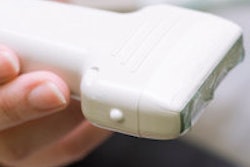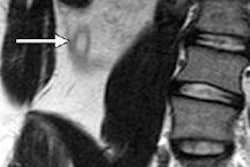
Using ultrasound as a first-line evaluation tool for patients suspected of having appendicitis -- and sending equivocal cases on to CT -- reduces radiation dose and saves healthcare dollars compared with a CT-only protocol, according to a new study in the January American Journal of Roentgenology.
 Laurence Parker, PhD.
Laurence Parker, PhD.
What really tips the scales in favor of ultrasound is its lack of radiation dose. When the downstream costs of CT radiation dose are included, using ultrasound first results in savings of more than $330 million, according to study authors Laurence Parker, PhD, Dr. Levon Nazarian, and colleagues (AJR, January 2014, Vol. 202:1, pp. 124-135).
Advantages of ultrasound
Ultrasound's advantages include its relatively low cost, wide availability, and lack of radiation; its perceived disadvantage is that it is more dependent on the operator's skill than other imaging tests, the authors wrote. CT is highly accurate for detecting acute appendicitis, but it is expensive and exposes patients to radiation.
 Dr. Levon Nazarian.
Dr. Levon Nazarian.
"The reason we did this study is that there are quite a few articles in the literature that compare how good ultrasound and CT are for the diagnosis of appendicitis, but we felt that none of them had an algorithmic approach that addressed the ramifications of the two technologies in terms of cost," Nazarian told AuntMinnie.com. "Just to compare CT to ultrasound for this purpose and to say that CT is more accurate than ultrasound, while true, only gives part of the story."
For their study, the researchers used information from the U.S. Centers for Medicare and Medicaid Services (CMS), national hospital discharge surveys, and U.S. Census Bureau life tables.
The group proposed the following imaging protocol: Patients presenting in the emergency department with right lower quadrant abdominal pain would receive an ultrasound first. If the ultrasound was positive, the patient would be sent for an appendectomy because ultrasound has a high positive predictive value for appendicitis.
However, if the ultrasound findings were negative or uncertain, patients would undergo a CT exam. If the CT findings were positive, they would have an appendectomy; if negative, no further treatment would be performed.
The group performed a meta-analysis of ultrasound's performance versus CT for detecting acute appendicitis.
| Ultrasound vs. CT for appendicitis | ||
| Ultrasound | CT | |
| Mean sensitivity | 87.5% | 93.4% |
| Mean specificity | 92.7% | 95.3% |
| Positive predictive value | 91% | 92.5% |
| Negative predictive value | 89.8% | 95.9% |
Meanwhile, the analysis of CMS files showed that CT was used for almost exactly two examinations per patient (one abdominal and one pelvic) and ultrasound was rarely used. The cost of the CT-only imaging protocol was $547 per patient, whereas the cost of a limited ultrasound study was $88 per patient. For the total U.S. population, the cost savings of an ultrasound-first protocol minus the cost of extra surgeries and extra surgical deaths would be $24.9 million per year, according to the authors.
High costs of radiation
Not only does the study underscore the cost savings an ultrasound-first protocol could provide, it emphasizes the surprisingly high downstream costs of radiation exposure in diagnostic imaging.
"The ultrasound-CT protocol we have proposed saves $24.9 million over the CT-only protocol when the costs of the tests and excess surgeries and mortalities from using a less sensitive test are considered," they wrote. "Radiation exposure savings are more than an order of magnitude greater -- $339.5 million."
Appendicitis evaluation represents another diagnostic imaging problem for which ultrasound could provide substantial cost savings but is underutilized, and when current radiation exposure models are applied to appendicitis evaluation, the number of excess cancer deaths resulting from current practice is striking -- approximately 50 full lives per year, the group wrote.
But clinicians should not necessarily stop using CT to evaluate appendicitis, Parker said.
"It's not that we're taking CT out of it," he said. "But if we can do an ultrasound first, we can avoid enough CTs to gain significant cost savings and avoid radiation exposure. It's interesting that a slightly less accurate technique is actually superior when you look at the big picture."





















